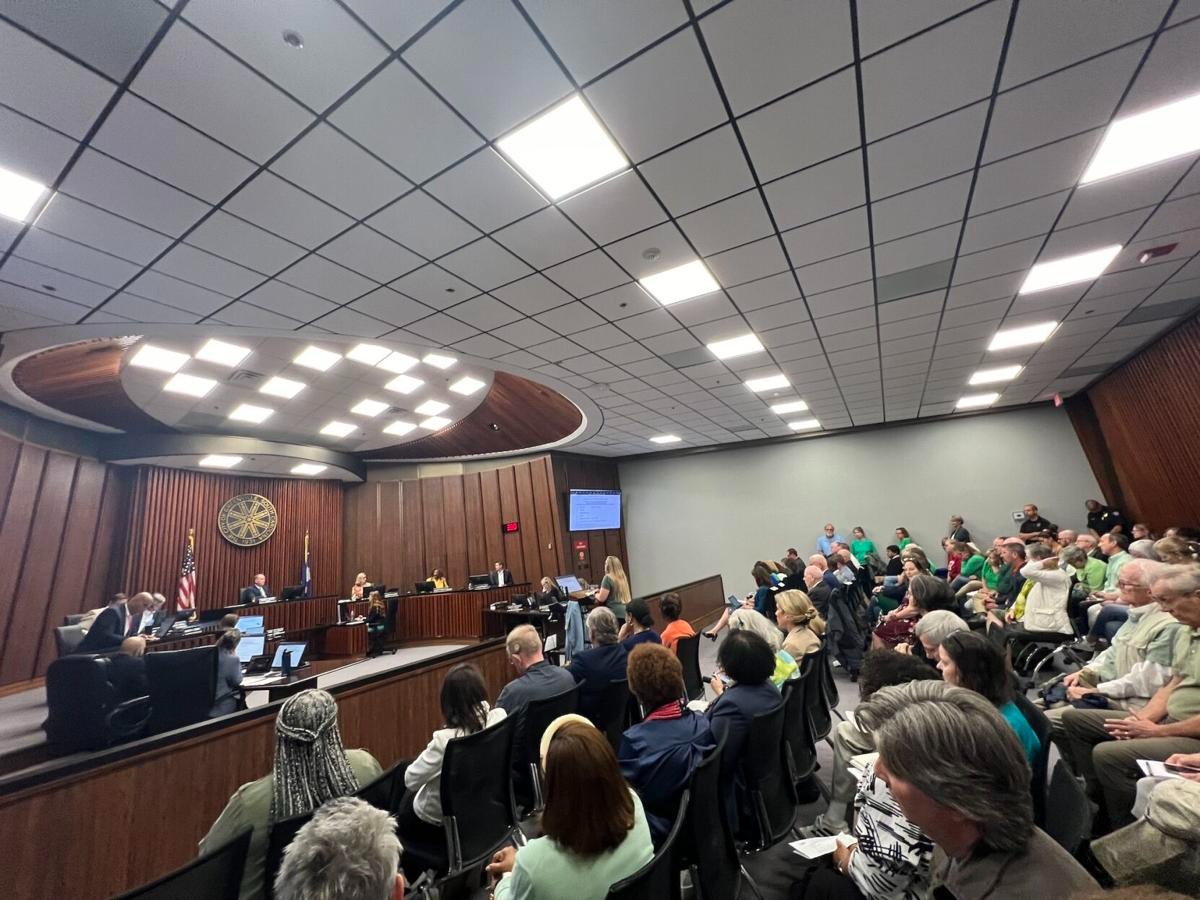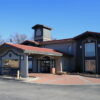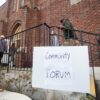By Spenver Donovan, Post and Courier
Citizens prosecuted Greenville’s commitment to affordable housing during an unusually long and tense City Council meeting, with some speakers praising city leaders for their action so far and others demanding they allocate more money to address the persistent housing crisis.
Members of the interfaith GOAL Justice coalition have asked the city to commit greater annual funding for the Greenville Housing Fund — a nonprofit the city created in 2017 with the prime goal of creating more affordable housing — with a portion of funds restricted to build housing for the lowest-income households.
That request has been met with defense and pushback from the mayor and City Council members, who said at their May 13 meeting that the housing fund wasn’t the only tool to address the affordable housing crisis, and that they lead municipalities across the state and county in investments on the issue.
Some council members have publicly called GOAL’s methods adversarial.
The group invited the mayor and council to publicly commit to more spending at a rally attended by 1,600 people in April, but only one council member attended, and she said the city was already doing enough.
City leaders have repeatedly said they’re doing all they can to address the housing crisis in Greenville, whose identity in the last 30 years has metamorphosed from that of a struggling former mill town to a growing city known for its vibrant downtown popular in national travel lists.
But despite the city’s efforts to build housing in lower-income Black communities, the influx of higher income White residents that in recent decades has fueled skyrocketing property values has priced out Black renters in particular. Greenville’s Black population has fallen in recent years, while its White population has dramatically increased.
In recent years, that has prompted an outcry as Greenville’s historically Black, lower-income communities face tidal waves of gentrification. Some of these special emphasis neighborhoods — as designated by the city — are now majority White and higher-income.
Feliccia Smith, who works on GOAL’s housing committee, asked City Council at its May 13 meeting to prioritize creation of affordable housing and help maintain existing lower-income housing units, which sometimes have shoddy renovations and poor, dangerous maintenance conditions.
She said she supports the $12.1 million in affordable housing funds that the city is providing in its budget this year, but she asked that one-third of that money be reserved for the lowest-income earners.
“People from all walks of life are affected,” Smith said. “Teachers, police officers, firefighters, veterans and so many more that work in and make Greenville the community that we all love. However, many are finding it impossible to afford to live in ‘Yeah, That Greenville.’”
GOAL Justice, which stands for Greenville Organized for Accountable Leadership, is a coalition of congregations from different faiths in the greater Greenville area.
They’ve asked the city of Greenville and Greenville County to contribute a combined $20 million annually with two organizations that create affordable housing: Greenville Housing Fund for the city and the Greenville County Redevelopment Authority for the county.
In April, GOAL invited the mayor and City Council to publicly commit $10 million in recurring, annual contributions to the housing fund by the fiscal year that begins in July 2025. One-third of that, GOAL has asked, must be reserved for households annually making 30 percent of the area median income, or about $27,000.
The $20 million in combined local spending, GOAL has said, is needed to help the more than 30,000, or about 7 percent, of Greenville County households that cannot afford their housing.
At the April rally, more than 1,600 people packed a Simpsonville church to ask city and county leaders to answer their questions publicly.
Only Councilwoman Lillian Brock-Flemming attended from the city council, and she said that was because she missed the event last year because of illness. She answered yes to GOAL’s requests, but made the caveat that she believes the city already has committed to the amount of money GOAL requested.
At the May 13 council meeting, Flemming acknowledged part of the problem but said that it’s an issue affecting communities across the country.
“We have lost a lot of wonderful people in the city of Greenville because they could not find places to live,” said Flemming, who has served on council for more than 40 years.
She said the city had to focus on other investments, too, like building sidewalks and repaving streets in the long-neglected special emphasis neighborhoods, and protecting open space to help provide clean air.
Under criticism from public speakers, the mayor and City Council members defended their support for affordable housing, with some saying they were open to exploring new ways but saying GOAL’s requests weren’t effective, realistic or even legal. They had back-and-forth discussions with speakers during the public comment portion of the May 13 meeting, which isn’t common for council members to do.
This year, the city has a $2.5 million contribution to the Greenville Housing Fund in its proposed budget. However, that money has already been reserved to pay back part of a $12 million loan the housing fund took out to jump-start construction.
Council members rattled off other contributions in the proposed budget, such as the city’s community development department, which is funded with grants from the federal Department of Housing and Urban Development, and whose staff are paid at least in part with those federal funds.
White said all of the city’s fee-in-lieu of tax, or “FILOT,” programs, will have a portion set aside dedicated for affordable housing. For example, 20 percent of the city’s tree fund will be reserved for tree plantings on affordable housing projects, City Councilwoman Dorothy Dowe said. The idea is to help developers lower costs to make affordable housing construction financially viable.
The city recently purchased the site of an old church near Unity Park to reserve the land for workforce housing with about $1 million in local tourism tax revenues. Other nearby property that was donated to the city for affordable housing was recently rezoned, meaning the contractor can move ahead with the building process.
Still, GOAL representatives said the city wasn’t using best practices for addressing the root of the problem: a critical shortage of affordable housing.
One particularly tense exchange came when Kat Stellern, who works in the city and lives in the county, told the council the housing fund wasn’t organized effectively.
The national best practice to make a housing fund work, Stellern said, requires a dedicated income stream and an ordinance that governs how that fund is allocated.
“The Greenville Housing Fund lacks both of those things, and so it is impotent, said Stellern, who’s involved with GOAL. “It is not successful like other housing funds that have been successful across our country.”
Stellern referenced plans from cities like Raleigh, N.C. But council members said that under South Carolina law, they can’t pass an ordinance restricting funds that will be spent by future iterations of council.
Stellern repeated the requests from GOAL, and said she supports the city’s upcoming budget and its $12 million support for affordable housing. But she said that still isn’t enough.
Mayor Knox White responded.
“I think you might want to start by talking to members of the housing fund about what they think they need to do their job and why,” White said. “I’m not so sure the way you describe it is actually the best approach, but we can have more discussions about that.”
Later in the meeting, Tiffany Santagati, vice president of operations for the housing fund, thanked the city for its $35 million support and for its “unwavering commitment” to the housing fund.
The money has contributed to more than 1,500 new homes, she said, 10 percent of which have been reserved for people making 30 percent AMI and below.
“Your commitment to provide affordable, stable and safe housing has been remarkable and honestly life changing to so many people,” Santagati said.
In addressing Stellern, White said the city has partnered with multiple developers and providers that work on projects for households at the lowest income levels, including Homes of Hope and Genesis Homes.
Stellern said they had met with those entities, who said they cannot reach the 30 percent AMI range and below because it is too costly.
“And so we are here as a faith-based organization to give you all the moral impetus to do what is hard and what seems impossible, and that is to reach those that are the least of these that need the most help.” Stellern said.
City Councilman John DeWorken asked Stellern if the GOAL coalition had made similar requests of other cities throughout Greenville County.
“Have you addressed the other municipalities with this same passion?” DeWorken said.
Stellern said they were working with to establish a relationship with those other cities through the Greenville County government, adding that the combined budgets of those cities — roughly $168 million for the fiscal year ending this summer — doesn’t come close to the budget for the city of Greenville, which has a budget of about $267 million.
“We recognize that the problem we started in the city is going to start showing up in those other municipalities,” Stellern said. “You all have the start of the problem because this is where the start of the transformation in our community came from. You guys have always mentioned you’re willing to lead the way. That is what we’re asking for.”
View the original story here.






